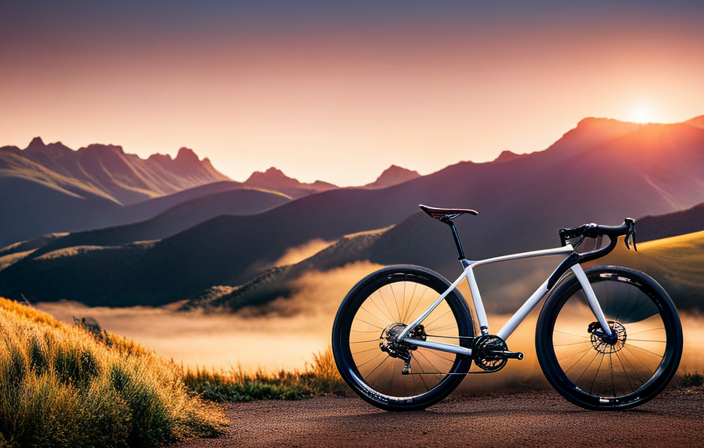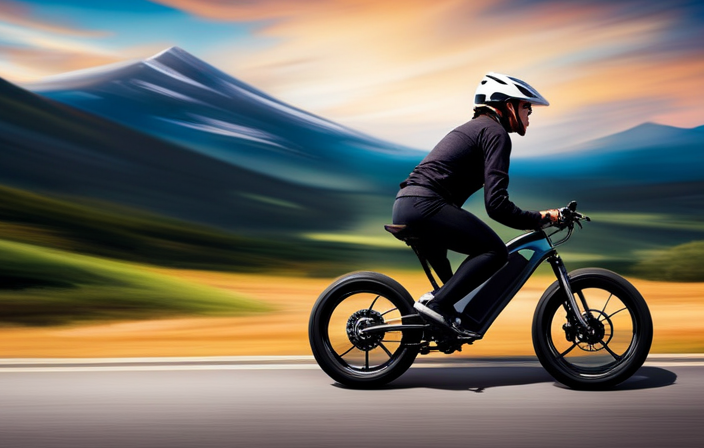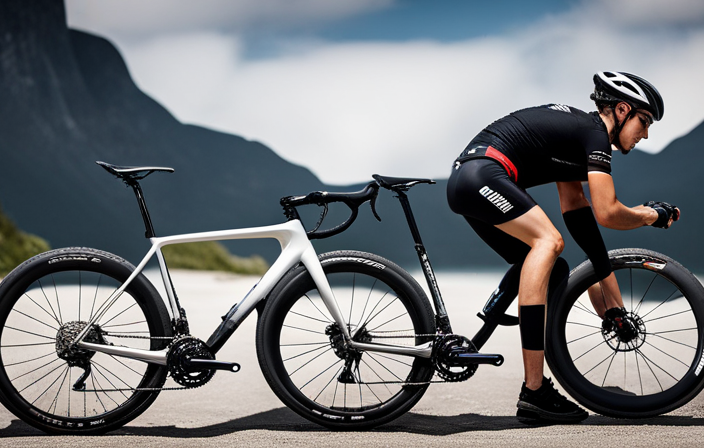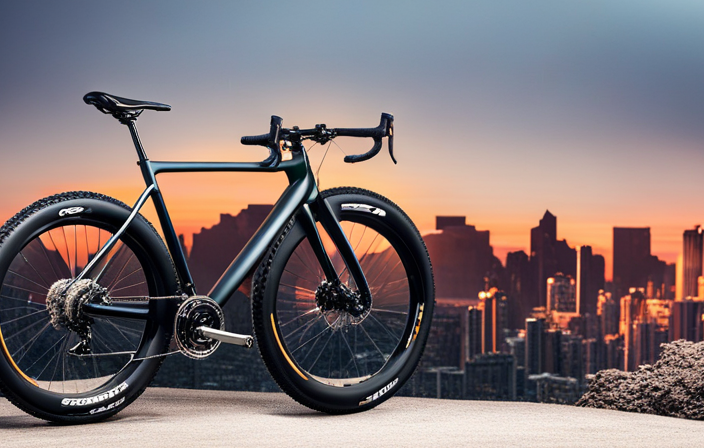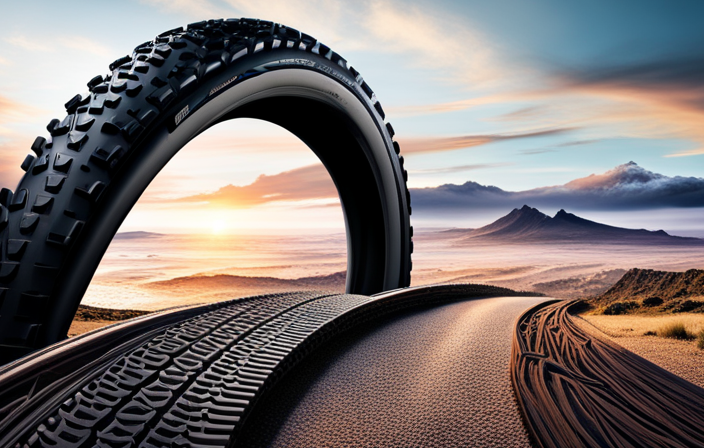Dive into the realm of gravel biking, where excitement and adventure merge! Are you prepared to tackle tough terrains and venture into unknown trails?
Before you embark on your thrilling journey, there’s one crucial question: what size tires should you choose for your gravel bike?
In this comprehensive guide, we’ll delve into the nitty-gritty details of tire sizes for gravel bikes. From understanding the basics to exploring different options, we’ll help you find the perfect fit for your off-road escapades.
So buckle up and get ready to roll!
Key Takeaways
- Lower tire pressures for better traction on loose surfaces
- Tire width affects stability and traction on uneven terrain
- Personal preference and riding style play a role in tire size selection
- Wider tires offer better grip and stability on loose surfaces
Understanding the Basics of Gravel Biking
Gravel biking is a fun and adventurous way to explore off-road trails. When it comes to gravel biking, finding the right tire pressure is crucial for a smooth and enjoyable ride. Unlike road biking where higher pressures are preferred, gravel biking requires lower tire pressures to improve traction on loose surfaces. Lowering the tire pressure allows the tires to conform to the terrain, providing better control and grip.
Another important consideration when it comes to gravel bike tires is whether to go tubeless or use inner tubes. Tubeless tires have gained popularity in recent years due to their numerous benefits. They eliminate the need for tubes, reducing the risk of flats caused by punctures or pinch flats. Tubeless tires can also be run at lower pressures without risking pinch flats, further enhancing traction and comfort on rough terrain.
Moving forward into factors to consider when choosing tire size for your gravel bike, it’s essential to find a balance between width and tread pattern that suits your riding style and terrain conditions. So let’s dive deeper into these factors that play a significant role in optimizing your gravel bike setup.
Factors to Consider When Choosing Tire Size
When choosing the right tire for your off-road cycling adventures, it’s important to take into account several factors. One of the most crucial considerations is the width of the tire. The wider the tire, the more stability and traction you will have on uneven terrain. Generally speaking, gravel bikes tend to have wider tires compared to road bikes to handle rougher surfaces.
When evaluating terrain conditions, think about the type of gravel you’ll be riding on. If it’s loose or deep gravel, a wider tire with knobs or a more aggressive tread pattern will provide better grip and control.
However, if you’ll be riding on mostly hard-packed gravel or paved roads with occasional off-road sections, a narrower tire might suffice. It’s also worth considering your personal preference and riding style. Some riders prefer a wider tire for added comfort and confidence over rough surfaces, while others prioritize speed and opt for a narrower profile.
In conclusion, when choosing tire size for your gravel bike, consider both the width of the tire and evaluate the terrain conditions you’ll encounter. Taking these factors into account will help ensure that you have an enjoyable and safe ride.
Now let’s move on to discussing common tire sizes for gravel bikes without missing a beat.
Common Tire Sizes for Gravel Bikes
When it comes to common tire sizes for gravel bikes, there are a few key options that you should consider.
One option is the 700c x 40mm tire, which offers a good balance of speed and traction on both paved and unpaved surfaces.
Another popular choice is the 650b x 47mm tire, which provides added cushioning and stability for rougher terrain.
If you’re looking for even more off-road capability, you might consider the 27.5′ x 2.1′ tire size. This larger diameter tire offers increased traction and control on loose or muddy trails.
Finally, the 26′ x 2.0′ tire is a versatile option that can handle a variety of terrains with ease.
Overall, choosing the right tire size for your gravel bike depends on your riding style and the type of terrain you plan to tackle. It’s important to consider factors such as grip, rolling resistance, and overall comfort when making your decision.
700c x 40mm
You’ll want to consider using 40mm tires for your gravel bike. These tires provide the perfect balance between speed and stability on rough terrain.
When it comes to bike tire pressure, it’s important to find the right PSI that suits your riding style and weight. Lower pressures can offer more traction and comfort, but may increase the risk of pinch flats.
Tubeless tires are becoming increasingly popular in the gravel biking community due to their ability to run at lower pressures without sacrificing performance or risking flats. However, if you prefer a more traditional setup, tubed tires are still a reliable option.
Moving on to 47mm tires, these wider options provide even more stability and control on loose surfaces. They excel in muddy conditions and offer enhanced grip when cornering.
650b x 47mm
If you’re looking for more stability and control on loose surfaces, consider going for wider b x 47mm options. These tires provide a larger contact patch with the ground, giving you better traction and handling in challenging conditions.
When it comes to finding tire pressure, it’s important to strike a balance between comfort and performance. Lower pressures can improve grip on rough terrain, but may increase the risk of pinch flats. Tubeless tires are becoming increasingly popular in gravel biking due to their ability to run lower pressures without the risk of pinch flats. They also offer improved puncture resistance compared to tubed tires.
Transitioning into the subsequent section about x 2.1 tires, if you’re really tackling rough and technical trails, you may want to consider even wider options for maximum control and confidence.
27.5" x 2.1"
For maximum control and confidence on rough and technical trails, go for wider 5′ x 2.1′ options. These tires offer exceptional traction and stability, allowing you to tackle challenging terrain with ease.
Understanding tire pressure is crucial when selecting the right set of tires. With wider options like the 5′ x 2.1′, you can run lower pressures without sacrificing performance, as the extra width provides additional support and prevents pinch flats.
Comparing different tire widths reveals that the 5′ x 2.1′ strikes a perfect balance between grip and rolling resistance, making it ideal for gravel riding. Its increased volume also helps absorb vibrations, enhancing comfort during long rides.
Transitioning into the subsequent section about ‘x 2.0”, we can explore another option that offers slightly less width but potentially improved speed without compromising too much on control.
- Enhanced traction on loose surfaces
- Improved stability over technical terrain
- Lower tire pressure for better comfort
- Increased volume for reduced vibration
- Balanced grip and rolling resistance
26" x 2.0"
After discussing the 5′ x 2.1′ tire size for gravel bikes, let’s move on to the current subtopic of an ‘x 2.0’ tire size.
When it comes to bike tire pressure, it is important to choose the right size for optimal performance and comfort on different terrains. The ‘x 2.0′ tire size offers a slightly narrower profile compared to the previous 5′ x 2.1’, providing better rolling efficiency without compromising too much on grip and stability.
Additionally, riders have the option of going tubeless or using tubes with these tires. Tubeless setups allow for lower pressures and increased traction, while tubed setups provide simplicity and ease of maintenance. It’s crucial to consider your riding preferences and terrain conditions before deciding between tubeless or tubed systems for this tire size.
Moving forward, let’s explore the pros and cons of different sizes in more detail…
Pros and Cons of Different Tire Sizes
One of the pros of different tire sizes is that they offer varying levels of traction and stability. When it comes to gravel biking, wider tires have several benefits. They provide better grip on loose surfaces, such as gravel or dirt roads, which enhances your control and confidence while riding. Wider tires also absorb more vibrations, making for a smoother and more comfortable ride over rough terrain.
Additionally, wider tires allow you to run lower air pressure, further improving traction by increasing the contact patch with the ground. This can be particularly advantageous when navigating steep descents or cornering at higher speeds.
On the other hand, there are some potential drawbacks to consider with wider tires. They tend to be heavier than narrower options, which can affect overall bike performance and acceleration. Moreover, they may not roll as smoothly on paved surfaces due to increased rolling resistance.
Finding the right tire size for your gravel bike is crucial in optimizing your riding experience. It depends on various factors such as your preferred terrain, riding style, and personal preferences. By considering these aspects along with tips for tire maintenance and the benefits of wider tires discussed above, you can choose a tire size that best suits your needs without compromising performance or comfort.
Finding the Right Tire Size for Your Gravel Bike
When it comes to finding the right tire size for your gravel bike, there are a few key points to consider.
First, think about your riding preferences and what type of terrain you plan on tackling.
Consult with bike experts who can provide valuable insight and recommendations based on your specific needs.
Finally, don’t be afraid to test out different sizes to see which one offers the best combination of performance and comfort for your gravel adventures.
Consider Your Riding Preferences
If you’re unsure about the size of tires for your gravel bike, it’s important to consider your riding preferences. Your riding style plays a crucial role in determining the right tire size.
Here are three factors to keep in mind:
-
Riding Style: Are you an aggressive rider who loves tackling challenging terrains? Opting for wider tires with a larger volume can provide better stability and grip during fast descents and cornering.
-
Tire Pressure: Adjusting tire pressure can significantly impact your ride experience. Lower pressures offer more comfort and traction on rough surfaces, but they may increase rolling resistance on smoother roads.
-
Terrain Conditions: Think about the type of terrain you’ll be riding on most frequently. If you primarily ride on loose gravel or muddy trails, wider tires with more aggressive tread patterns will excel in providing traction and control.
Considering these factors will help you find the perfect tire size for your gravel bike. Once you have narrowed down your options, consult with bike experts to ensure that you make an informed decision before hitting the trails again.
Consult with Bike Experts
To make an informed decision about the right tire size for your gravel bike, it’s a good idea to consult with experts in the field. Bike fit and tire pressure are crucial factors to consider when determining the appropriate tire size. Consulting with bike experts will provide valuable insights into these aspects and help you find the perfect balance for your riding preferences.
Here is a table that showcases how different tire sizes can affect bike fit and tire pressure:
| Tire Size | Bike Fit | Tire Pressure |
|---|---|---|
| 700x35c | Narrower tires may provide a more aerodynamic position but may sacrifice stability on rough terrain. | Higher pressures may result in less rolling resistance but can also lead to a harsher ride. |
| 650b x 47c | Wider tires offer increased stability and better traction on loose surfaces. | Lower pressures provide enhanced comfort and improved grip, especially on uneven terrains. |
| 29×2.0 | Larger wheel diameter provides superior rollover ability for obstacles, improving overall efficiency. | Lower pressures allow for better shock absorption and increased traction on technical trails. |
By consulting with experts, you can gain valuable knowledge about finding the ideal tire size that suits your needs based on bike fit and desired tire pressure levels. This information will be useful as you test different sizes to determine which one offers optimal performance without compromising comfort or control of your gravel bike.
Test Different Sizes
When it comes to finding the right tire size for your gravel bike, consulting with bike experts is crucial. However, it’s also important to test different sizes yourself to see what works best for you. As an experienced cyclist, I have found that experimenting with various tire sizes can greatly impact the overall performance and handling of the bike.
Here are three key factors to consider when testing different tire sizes:
-
Tire pressure recommendations: Different tire sizes require different pressures to optimize performance and comfort.
-
Impact of tire size on bike handling: Larger tires provide more stability and traction on rough terrain, while smaller tires offer faster acceleration and improved maneuverability.
-
Personal preference: Ultimately, the choice of tire size depends on individual riding style and terrain preferences.
By understanding these factors and testing various tire sizes, you can find the perfect fit for your gravel bike that enhances both comfort and performance.
Now let’s delve into the importance of proper tire maintenance and care in ensuring optimal biking experience.
Tire Maintenance and Care
For proper tire maintenance and care on your gravel bike, make sure to regularly inspect the tread and pressure. Maintaining optimal bike tire inflation is crucial for preventing flats and ensuring a smooth ride on various terrains. Start by checking the recommended tire pressure specified by the manufacturer. Use a reliable pressure gauge to accurately measure the air pressure in your tires. Adjust as needed to meet the recommended range.
Next, inspect the tread of your tires for any signs of wear or damage. Look out for cuts, punctures, or excessive wear that may compromise the performance and safety of your tires. Replace worn-out tires promptly to avoid potential hazards while riding.
It is also important to keep your tires clean from debris such as mud, gravel, or small rocks that can get lodged in between the treads. Regularly wipe down your tires with a damp cloth after each ride to remove any accumulated dirt.
In addition to regular inspections, consider using sealant inside your tubes or tubeless setup to further prevent flats caused by punctures. Sealants work by sealing small holes automatically during rides.
By properly maintaining and caring for your gravel bike’s tires, you can enhance their lifespan and maximize performance. Now let’s dive into popular tire brands for gravel biking without skipping a beat.
Popular Tire Brands for Gravel Biking
Moving on from tire maintenance and care, let’s dive into the world of popular tire brands for gravel biking. As a passionate cyclist, I’ve spent countless hours researching and testing various tire brands to find the perfect fit for my gravel bike. When it comes to tackling rugged terrains and unpredictable surfaces, having the right tires is crucial.
One important consideration when choosing tires for your gravel bike is finding the optimal tire pressure. It can significantly impact your ride quality and overall performance. Additionally, opting for a tubeless setup can provide several advantages such as reduced punctures, lower rolling resistance, and enhanced grip.
Now, let me share with you three exceptional tire brands that have earned their reputation in the gravel biking community:
- Schwalbe: Known for their durable construction and excellent traction on loose surfaces.
- Panaracer: Offers a wide range of tread patterns suitable for different terrain conditions.
- WTB (Wilderness Trail Bikes): Provides high-quality tires with superior sidewall protection against cuts and abrasions.
These brands prioritize innovation and design to deliver top-notch performance on adventurous rides.
Now that we’ve explored popular tire brands, let’s move forward to our next topic – tips for choosing the right tread pattern that suits your riding style and trail conditions seamlessly.
Tips for Choosing the Right Tread Pattern
To ensure optimal performance on various terrains and trail conditions, it’s essential to consider the right tread pattern for your preferred style of riding. The tread pattern plays a crucial role in providing traction, stability, and control on gravel roads. When choosing a tire for your gravel bike, there are several factors to consider, including the type of terrain you’ll be riding on and your personal preferences.
One important aspect to consider is the spacing between the knobs on the tire. Tires with widely spaced knobs offer better grip in loose conditions, such as gravel or mud, while tires with closer-spaced knobs provide more efficiency on hard-packed surfaces. Additionally, the height and shape of the knobs also affect performance. Higher knobs provide more grip in soft terrain but can slow you down on harder surfaces.
Another factor to take into account is tire pressure. The ideal pressure for gravel biking depends on various factors like rider weight, bike weight, terrain conditions, and personal preference. Generally speaking, lower pressures allow for better traction and comfort but can increase rolling resistance. Higher pressures reduce rolling resistance but may sacrifice traction in loose conditions.
When selecting a tire tread pattern and determining the appropriate tire pressure for your gravel bike adventures, it’s crucial to find a balance that suits your riding style and provides confidence across different terrains.
Now let’s explore some accessories that can enhance your gravel biking experience…
Accessories for Enhancing Your Gravel Biking Experience
Explore a range of accessories that can enhance your gravel biking experience and make your rides more enjoyable.
When it comes to bikepacking essentials, having the right gear is crucial. A sturdy saddlebag or frame bag can provide ample storage space for all your camping gear and equipment, ensuring that you have everything you need for those long rides in the wilderness. Additionally, investing in a good quality hydration pack or water bottle cage will keep you hydrated throughout your journey.
Nutrition plays a vital role in maintaining energy levels during extended rides. Snacks such as energy bars, gels, and electrolyte drinks are essential to replenish lost nutrients and keep you going on those challenging terrains. It’s also worth considering a handlebar bag or top tube bag to easily access these snacks without having to stop.
As we transition into discussing tire upgrades and customization options, it’s important to note that these accessories mentioned earlier are just as important as any other upgrade on your gravel bike. They enable you to go further and stay comfortable during longer rides while carrying all the necessary supplies.
So let’s dive into the world of tire upgrades and customization options for even better gravel biking experiences!
Tire Upgrades and Customization Options
One way to enhance your gravel biking experience is by upgrading and customizing the tires on your bicycle. Custom tire options allow you to choose the perfect tire for your specific riding needs.
Here are three key factors to consider when selecting and customizing your gravel bike tires:
-
Tread Pattern: Gravel bike tires come in various tread patterns, each designed for different terrains. For loose or muddy trails, opt for a tire with aggressive knobs that provide excellent traction. On the other hand, if you’ll be riding mostly on hard-packed surfaces, a tire with a smoother center tread will offer low rolling resistance.
-
Tire Width: The width of your gravel bike tires plays a crucial role in determining comfort and performance. Wider tires (around 40mm) provide more stability and grip on rough terrain, while narrower ones (around 30mm) are better suited for smoother roads.
-
Tire Pressure Recommendations: Proper tire pressure is essential for optimal performance and comfort on gravel roads. Generally, lower tire pressures (around 35-45 psi) are recommended for improved traction and shock absorption.
Upgrading and customizing your gravel bike tires can significantly enhance your riding experience by improving traction, comfort, and control on various terrains. However, it’s also important to consider safety considerations when venturing out onto gravel roads without compromising speed or agility.
Safety Considerations for Gravel Biking
When it comes to safety considerations for gravel biking, there are three key points that I want to discuss.
First and foremost, wearing a properly fitted helmet is essential to protect your head in case of a fall or collision.
Additionally, investing in high visibility clothing and accessories, such as reflective gear and bike lights, can greatly improve your visibility to others on the road.
Lastly, mastering riding techniques for various terrains like loose gravel or rocky surfaces is crucial in order to maintain control and prevent accidents.
Helmet and Protective Gear
Make sure you wear a helmet and other protective gear while riding your gravel bike. Helmet safety is crucial in any type of cycling, as it protects your head from potential injuries in case of a fall or collision.
When choosing a helmet, look for one that meets safety standards such as CPSC or EN1078. It should fit snugly on your head and have adjustable straps for a secure fit.
Additionally, consider wearing other protective gear such as knee and elbow pads, gloves, and padded shorts to protect vulnerable areas of your body. There are various options available depending on your preferences and the level of protection you desire.
Now that we’ve covered the importance of helmet safety and protective gear, let’s move on to discussing bike lights and reflectors to enhance visibility during rides.
Bike Lights and Reflectors
To enhance your visibility during rides, it’s important to have bike lights and reflectors on your gear. Bike lights are essential for riding in low-light conditions or at night. When choosing bike lights, consider the brightness level needed for your specific riding environment. Look for lights with high lumens for maximum visibility. Some lights even have different modes like flashing or strobe settings to catch the attention of drivers and pedestrians.
Additionally, reflective clothing options can further increase your visibility on the road. Reflective vests, jackets, and ankle bands are great choices that can be easily seen by motorists from a distance. These options provide an extra layer of safety when combined with bike lights and should always be worn when riding in low-light conditions or at night.
Now let’s transition into discussing riding techniques for different terrains without skipping a beat.
Riding Techniques for Different Terrains
Get ready to adapt your riding technique for various terrains! Riding techniques and bike handling are crucial when it comes to tackling different types of surfaces. Here are some key tips to keep in mind:
-
Body Position: Adjust your body position based on the terrain. For steep descents, shift your weight back and lower your center of gravity. On loose gravel, distribute your weight evenly to maintain traction.
-
Braking Technique: Use both brakes simultaneously for efficient stopping power. Feather the brakes in wet or muddy conditions to avoid skidding.
-
Cornering: Lean into turns while keeping your weight balanced over the bike. Look ahead and anticipate any obstacles or changes in terrain.
-
Climbing: Shift to a lower gear before starting a climb and maintain a steady cadence. Distribute your weight evenly between the handlebars and saddle for better traction.
-
Descending: Keep a relaxed grip on the handlebars, use both brakes judiciously, and shift your weight back for stability.
By mastering these riding techniques, you’ll be able to confidently navigate various terrains with ease.
Now let’s transition into discussing riding etiquette and environmental responsibility.
Riding Etiquette and Environmental Responsibility
When it comes to riding etiquette and environmental responsibility, there are three key points that should always be kept in mind: Leave No Trace Principles, respect for wildlife, and respect for natural habitats.
As an avid gravel biker, I understand the importance of minimizing my impact on the environment. This means following Leave No Trace Principles such as packing out all trash, staying on designated trails, and avoiding damaging vegetation or disturbing wildlife.
Additionally, showing respect for wildlife by keeping a safe distance and not feeding or approaching them is crucial. Finally, respecting natural habitats means being aware of sensitive areas and avoiding riding through them to preserve their integrity.
By practicing these principles, we can ensure that future generations can enjoy the beauty of nature while gravel biking responsibly.
Leave No Trace Principles
The Leave No Trace Principles are important to consider when riding a gravel bike. These principles guide us in being responsible riders and minimizing our impact on the environment while enjoying this outdoor activity. Here are four key aspects of the Leave No Trace Principles that apply to sustainable gravel biking initiatives:
-
Tire Pressure: Maintaining appropriate tire pressure is crucial to minimize trail damage and prevent erosion. By using lower tire pressure, we distribute our weight more evenly, reducing the impact on the terrain.
-
Pack It In, Pack It Out: Carry out all your trash and dispose of it properly. This includes any food wrappers, water bottles, or other waste generated during your ride.
-
Stay on Designated Trails: Stick to established trails to avoid disturbing wildlife habitats and sensitive plant communities.
-
Respect Wildlife and Natural Habitats: Keep a safe distance from animals you encounter and refrain from feeding or approaching them.
Considering these principles ensures that we can enjoy our gravel biking adventures while respecting wildlife and natural habitats without damaging them further.
Respect for Wildlife and Natural Habitats
When it comes to eco-friendly biking practices and wildlife conservation, it is crucial for gravel bikers like myself to exercise respect for wildlife and natural habitats.
As we explore the great outdoors on our bikes, we must remember that we are entering the homes of countless species, some of which may be vulnerable or endangered.
To minimize our impact, it is essential to stay on designated trails and avoid disturbing any wildlife we encounter along the way.
By practicing Leave No Trace principles and being mindful of our surroundings, we can ensure that our gravel bike adventures do not harm the delicate balance of nature.
Now, let’s transition into discussing recommended gravel bike routes and destinations where we can continue to enjoy this exhilarating sport in a responsible manner.
Recommended Gravel Bike Routes and Destinations
You’ll find plenty of recommended gravel bike routes and destinations to explore. When it comes to choosing the best routes, there are a few factors to consider.
Firstly, look for recommended bikepacking routes that have been tried and tested by experienced cyclists. These routes often provide a great mix of challenging terrain, scenic views, and camping opportunities along the way.
In addition to bikepacking routes, gravel bike events and races can also offer exciting opportunities for exploration. These organized events often take participants through some of the most beautiful and challenging gravel roads in the area. They provide a chance to push your limits while surrounded by like-minded individuals who share your passion for gravel biking.
When selecting a destination, it’s important to consider the type of terrain you prefer riding on. Some areas offer smoother gravel roads that are well-suited for beginners or those looking for a more relaxed ride. On the other hand, if you’re seeking an adrenaline-pumping adventure, you may want to choose destinations with rougher and more technical terrain.
As I transition into the next section about personal stories and experiences from gravel biking enthusiasts, it’s clear that there is no shortage of incredible gravel bike routes and destinations waiting to be discovered.
Personal Stories and Experiences from Gravel Biking Enthusiasts
When it comes to gravel biking, there is no shortage of personal stories and experiences from enthusiasts who have taken their bikes off the beaten path. These tales are filled with adventure, challenges, and triumphs that can inspire any rider looking to explore the world of gravel biking.
As a passionate gravel biker myself, I have had my fair share of unforgettable moments on the trails. From conquering steep climbs to navigating through rugged terrain, every ride has been a thrilling experience. But what truly enhances these adventures is having the right equipment, including gravel bike modifications and participating in gravel bike events.
To give you a deeper understanding of the world of gravel biking, I have compiled some insights from fellow riders in a table below:
| Gravel Bike Modifications | Gravel Bike Events |
|---|---|
| Tubeless tires for better traction | Gravel races with different distances |
| Wider handlebars for increased stability | Group rides with like-minded enthusiasts |
| Suspension forks for added comfort | Adventure tours exploring scenic routes |
These modifications and events not only enhance your performance but also provide opportunities to connect with other riders who share your passion.
Now that we’ve explored personal stories and experiences from gravel biking enthusiasts let’s dive into finding your perfect tire size for gravel biking.
Conclusion: Finding Your Perfect Tire Size for Gravel Biking
To wrap up, determining the ideal tire dimensions for your off-road cycling adventures can greatly impact your overall gravel biking experience. Finding the right tire pressure and opting for tubeless tires can provide numerous benefits that enhance your ride.
When it comes to finding the right tire pressure, it’s crucial to strike a balance between grip and rolling resistance. Lower pressures offer better traction on loose terrain, allowing you to confidently tackle challenging gravel paths. However, excessively low pressures can lead to pinch flats or burping in tubeless setups. On the other hand, higher pressures reduce rolling resistance and prevent punctures but sacrifice some grip on rough surfaces. Experimenting with different pressures is key to finding what works best for you and the specific conditions of your rides.
Tubeless tires are gaining popularity among gravel biking enthusiasts due to their numerous advantages. These tires eliminate the need for inner tubes, reducing rotating mass and increasing efficiency while offering enhanced puncture resistance. Tubeless setups also allow lower tire pressures without sacrificing performance, providing improved comfort and traction on uneven terrain.
In conclusion, by fine-tuning your tire pressure and considering tubeless options, you can optimize your gravel biking experience. Remember that personal preferences may vary based on riding style and conditions encountered during each adventure.
So go out there, experiment with different setups, and find the perfect tire size that maximizes both performance and enjoyment on those exhilarating off-road journeys!
Frequently Asked Questions
Can I use road bike tires on my gravel bike?
Yes, you can use slick tires on your gravel bike. However, it’s important to consider the advantages of using wider tires on a gravel bike.
Wider tires provide better stability and traction on loose surfaces, making them ideal for off-road riding. They also absorb more shock and vibrations, resulting in a smoother and more comfortable ride.
Additionally, wider tires allow for lower tire pressures, enhancing grip and reducing the risk of flats.
Are wider tires always better for gravel biking?
When it comes to gravel biking, the saying ‘bigger is better’ holds true.
While narrow tires may offer some advantages on smoother terrains, such as increased speed and reduced rolling resistance, they can struggle on rougher surfaces.
Wider tires provide more stability, traction, and comfort on various gravel terrains. They excel in loose gravel and uneven surfaces by absorbing shocks and offering better control.
However, they may sacrifice some speed on paved roads compared to narrower options.
How often should I replace my gravel bike tires?
Gravel bike tires typically last around 1500 to 3000 miles, depending on various factors. The lifespan of these tires can be affected by factors such as terrain conditions, tire pressure, riding style, and the quality of the tire itself.
Regular inspection is important to check for signs of wear and tear. If you notice significant tread wear or cuts in the sidewall, it’s time for a replacement. Additionally, rotating your tires regularly can help extend their lifespan.
Can I use tubeless tires on my gravel bike?
Tubeless tires are a great option for gravel bikes due to their numerous advantages. They provide better traction, lower rolling resistance, and increased puncture resistance compared to tubed tires. However, they can be trickier to set up initially and may require more maintenance.
When choosing the right tire width for your gravel bike, consider factors like terrain and personal preference. Wider tires (around 40-45mm) offer more stability on rougher surfaces, while narrower ones (around 30-35mm) provide better speed on smoother roads.
What tire pressure should I use for different gravel conditions?
For different tire widths, the ideal tire pressure will vary depending on the specific gravel conditions. In general, lower tire pressure offers several advantages. It increases traction by allowing the tire to conform better to uneven surfaces, reduces rolling resistance, and provides a more comfortable ride.
However, there are also some downsides to consider such as an increased risk of pinch flats and decreased efficiency on smoother surfaces. Ultimately, finding the right tire pressure involves experimentation and personal preference.
Conclusion
After exploring the various tire sizes for gravel biking and considering the pros and cons of each, I have come to the conclusion that finding the perfect tire size is essential for an optimal riding experience.
Just like a car’s tires, the right size can greatly impact performance and comfort on different terrains. Whether you prefer wider tires for added stability or narrower ones for increased speed, it’s important to choose a size that suits your riding style and preferences.
So go ahead, hit those gravel trails with confidence knowing that your perfectly sized tires will take you on an exhilarating ride.
